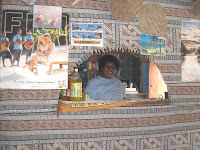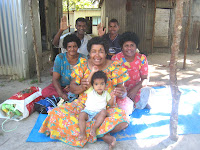October 5, 2009—Monday morning, September 28, we took the trail leading over the island to the windward side. The trail ended at the Sunshine Lagoon Resort, which is a backpackers resort. A woman named Sala called out to us and invited us to come into the dining hall, so we sat down to visit with her for awhile and found out that there are two other resorts on this side, the Coral View Resort and Gold Coast Resort. These three resorts are owned by Fijian families, which is unusual here; and, unfortunately, you can see the difference. The facilities were not as nice as the other resorts we have visited; however, we had to give them credit for being entrepreneurs.
When we left, we walked down the beach past the other two resorts and stopped at Kim’s Tea
.jpg)
Room at the end. The sign said, “Cold Beer,” so we went in to the small, but very quaint, thatched building. The woman behind the window introduced herself as Lo and asked us what we would like. Steve said a beer, but she said there was none, so we ordered two warm Fantas and a slice of chocolate cake. We sat down at the table and enjoyed the food, but we had to finish it quickly as the resident cat moved in quickly for any leftovers.
That evening we went ashore to the Nanuya Bay Resort where we enjoyed a wonderful meal of lamb chops with garlic mashed potatoes and sautéed okra. Both of us were surprised that the okra was so good. We also had a beautiful sunset that evening.
The next morning we went by sv Cheshire Cat to meet up with Mike, Justin, and Hazel. We took off in our dinghies across the bay and around the point of Matacawa Levu Island. At the
backpackers’ resort, we were able to get directions to the vegetable farm, which was just over the hill. We followed the trail, and when we came over the ridge, we saw a beautiful valley below us. We walked down and went to the house where we met Toki, who works the farm. We explained what we wanted, and he led us to the fields.
Throughout the process of getting our vegetables, we walked over quite a bit of land. The guys
.jpg)
all helped pick the vegetables and fruit. We bought carrots, tomatoes, jack beans, bell peppers, cabbage, beets, bananas, papaya, and coconuts. When our bag was full, Toki’s wife came over, examined the bag, and told us the cost was $25 Fijian or about $14 U.S. She did not charge us for the coconuts because they did not plant them. We happily paid her and then asked to take their picture. They work hard here, and Toki was very excited that he had just purchased a rototiller to make the work easier.
On Wednesday, September 30, we were listening to New Zealand radio on our SSB radio when they announced that an 8.3 earthquake had struck northwest of Samoa. Steve wrote the last blog posting about the situation. Since that posting we learned that one cruiser was lost in Pago Pago, American Samoa, when he was swept off his boat. We still do not know if any yachts were lost, but some were damaged. We heard that the family that we got to know in Nuitoputapu, Tonga, lost their home. The south shore of Samoa where we enjoyed lunch at a lovely resort was completely wiped out. We are still waiting for more accurate information. So far no cruisers that we know personally were affected.
We planned to leave Blue Lagoon and go south a few miles to Somosomo on Naviti Island, but we waited for a few hours to be sure that there would be no effects from the tsunami. We were able to enjoy a nice sail, which was nice for a change. A few miles down the coast, a school of dolphins crossed our path, and six of them broke off so that they could swim in our bow wave. It was fun to watch them because we have seen very few dolphins here in Fiji.
We arrived at Somosomo Village on Naviti Island around noon, so we decided to eat lunch and then go into the village. When we went ashore after lunch, three young men were waiting to help us pull our dinghy on shore. Two of them then took us to the chief’s home so that we could present our “sevusevu.” We entered the home, and Steve placed the kava in front of the chief, who was sitting on a mat on the floor. The chief then chanted a welcome in Fijian, accompanied by clapping his hands. When he was done, he shook our hands, and we were now free to walk around the village and to leave our boat anchored in the bay.
The village was very nice with shrub lined paths to all the buildings. We were taken to see the
,+Jerry,+and+Lucy.jpg)
Methodist church, which is one of three in this village. Of course, as we passed homes, the women would ask us to look at their handicrafts. We always try to purchase something from them, so I bought some material from one, and then we met Moce (Mothe), who had some nice shell earrings. I asked about a conch shell, and she sent her nephew off to get her sister. The sister brought a lovely conch shell that I really liked so I bought it. We got to meet all of the family, including little two-year-old Lucy, and really enjoyed our time with them. When we returned to the boat, it was late afternoon, and we just took it easy.
Around 10 o’clock the next morning Bill (the chief’s nephew) and Robert came out to the boat in

a kayak for a visit. They brought us two pumpkins and two coconuts, and we served them lemonade and ginger snap cookies. They visited with us for about an hour, talking about the village and their lives. We got out two large charts to show them where we had been over the past two seasons, and then Steve gave them a tour of the boat before they left. We had a very nice time with them.
Around noon we moved north just a bit to Narewa Bay on the same island and went ashore to a very long beach with beautiful white sand. We walked for quite a ways looking for, and finding, some nice shells. I have decided that I cannot take any more shells home so that will be it for this season. We enjoyed a beautiful sunset in the evening.
As we were pulling the anchor the next morning, we saw a very large sea turtle that surfaced close to the boat. We planned to go to the northern end of Waya; however, after sailing for about two hours, the wind picked up and was right on the nose so we had to motor once again. The seas were building, and we just didn’t want to pound into them, so we diverted to Manta Ray Bay. We anchored and put out the flopper stopper so we did not have too much roll. The wind continued to blow and then around five o’clock it suddenly stopped and was perfectly calm. Two hours later it was blowing once again—very strange.
The next day we planned to go about 20 miles back to Navadra, and we had great sailing for three hours. It was so good that we decided to continue on to Musket Cove. Of course, once we had passed Navadra, the winds died down, and we had to motor sail the rest of the way in to Musket. In the end we didn’t mind because it was such a lovely day.
We arrived in Musket around five in the evening and picked up a mooring ball. We then prepared lamb shanks with vegetables for dinner, which was exceptionally good. It had been a long day, so we crashed for the night. The next day we just took it easy and did little project s around the boat. We cooked steaks for dinner and then called it a night because we planned to leave early to return to Vuda Point Marina to prepare the boat for the haul out.
Our last leg back to Vuda Point felt a bit strange. We both agreed that we were anxious to go home, but we felt sad about leaving the boat. We were motoring so we made water and charged the batteries all the way. We arrived around nine o’clock and pulled into Slip 12, where we tied up the boat. It has been a good season.
Before ending this blog, I wanted to post our picture of the beautiful manta ray that we swam with.
.jpg)
.jpg)
,+Jerry,+and+Lucy.jpg)

.jpg)
.bmp)